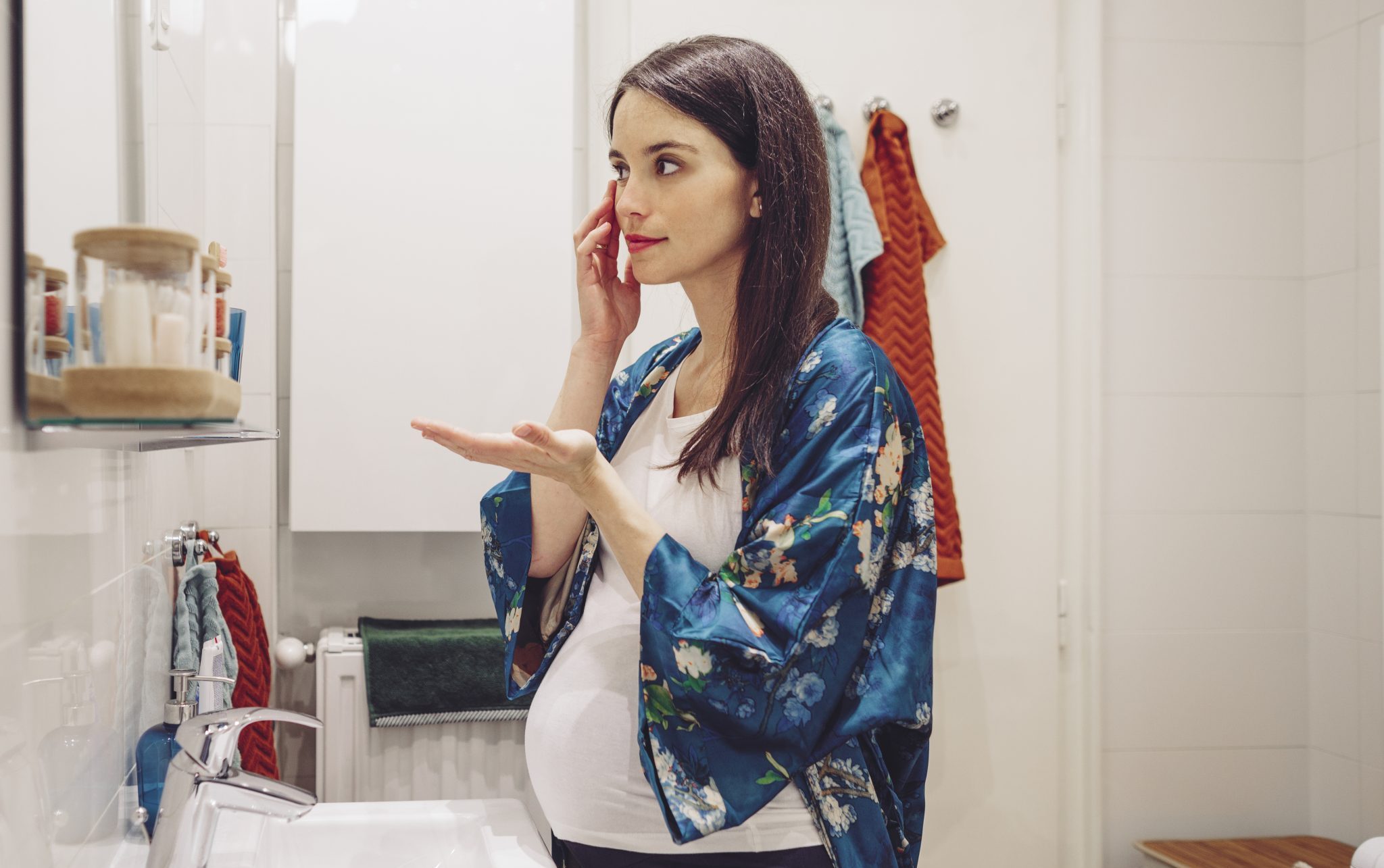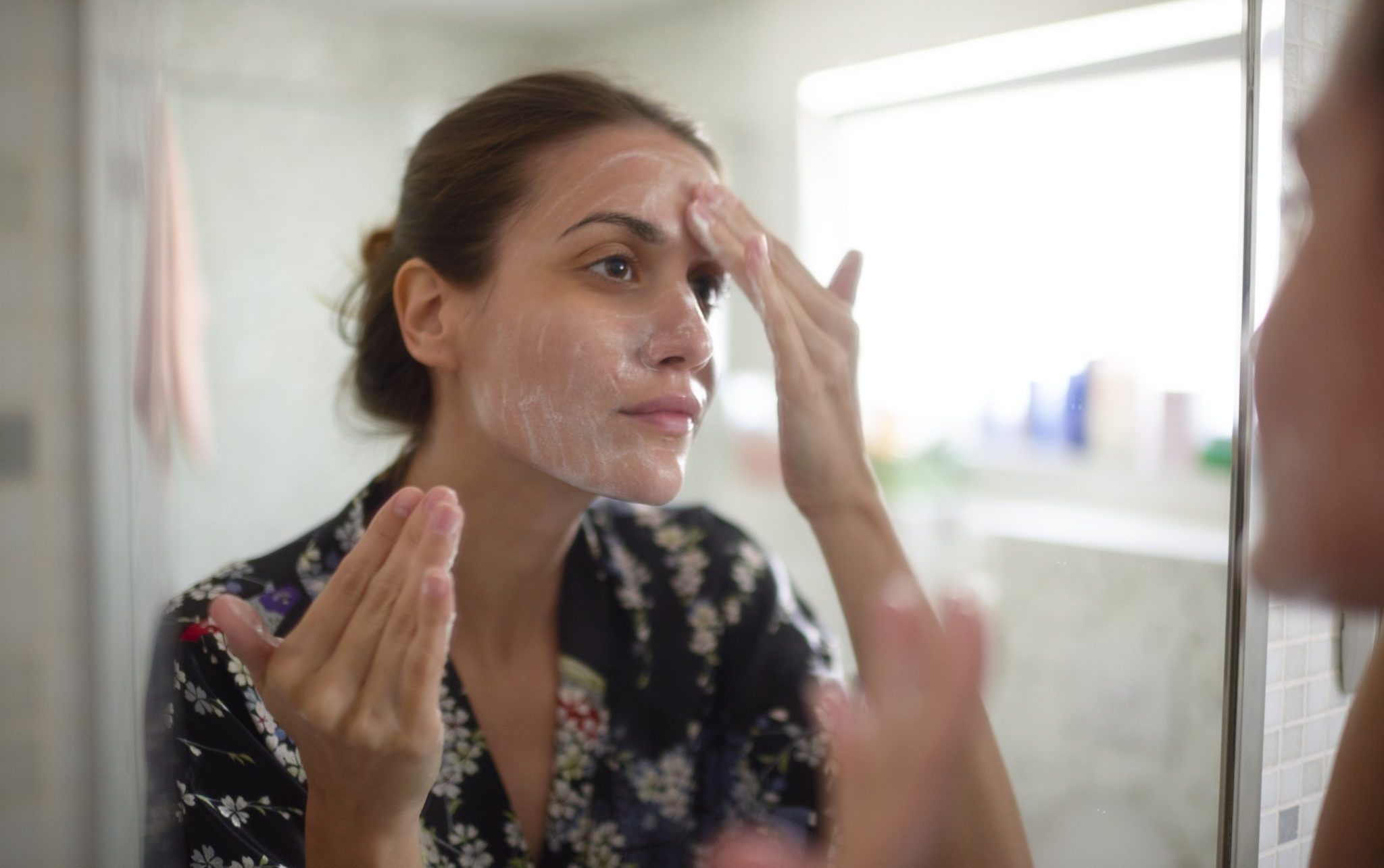I was a lucky teen. A few spots here and there, but nothing to write home about: I never thought much about acne back then, and while the common teenage issue plagued my friends, I sat calmly with reasonably ok skin and wondered what all the fuss was about. Then pregnancy rolled around. Enter first-trimester skins problems. Forget that glow that some women have from the minute they conceive. I was otherwise preoccupied with morning sickness – potatoes, baked beans, and water were my new best friends – and to top it all off, my skin erupted in a breakout. Not the symbol of impending motherhood I was expecting. So, between hugging the toilet bowl and trying to appear functional those first three months, I spent a lot of time researching hormonal acne treatments in the hopes of looking a little more human.
While not all acne is pregnancy related, hormones do play a huge role in the quality of our skin, and that applies whether you’re a man or a woman. The condition affects 50 million Americans annually – around 15% of the population – while the UK’s numbers estimate that for those aged 11 to 30, 80% can expect to have bad skin at some point. Though the condition is rarer in adulthood, 1% of males and 5% of females continue to have adult acne. So, if you’re a bad skin sufferer, you’re not alone, and there’s no need to hide in your bedroom for days on end waiting for those spots to disappear.
The low-down on problem skin

To prevent hormonal acne and any other type, you first have to get to know the beast; let’s get to grips with some of the main types and what they look like:
Vulgaris
Sounds gruesome, but this type is one of the more common ones. Usually suffers have blackheads, whiteheads, and full-blown spots. These can appear anywhere from your head to your toes and even your buttocks.
More severe sub-types of this issue include comedonal (appearing as bumps, blackheads, and milia), nodular (deep, red spots that are large and inflamed) and cystic (represents itself as large cystic spots, which are painful to the touch).
Usually, this occurs because of hormones with androgen increasing the oil that heads to and blocks your pores. There might also be a genetic link, making some people more vulnerable than others. For women, your approaching period might be a trigger.
To control hormonal acne, you should keep a good skin care regime, and if you find your skin particular bad, talk to your doctor about prescription medications and creams.
Rosacea
Even after 30, you can still be hit by a bout of skin problems. Rosacea is a condition that shows up as bumpy and red skin and may seem a little like a spotty rash.
Usually occurring in more men than women and localized to the facial area, this disorder could be caused by dilating blood vessels.
Dermatologists generally recommend that to reduce adult hormonal acne, heading to their office for a check-up is a must alongside a prescription of antibiotic cream or azelaic acid gel. Over-the-counter recipes can lead to dry skin or even make the problem worse.
Mechanica
Responding to outside sources, the mechanica type is caused by external factors such as heat, friction, or pressure on the skin.
The condition starts out as small bumps but can quickly progress and result in one huge acne problem.
This is a common complaint of athletes and those who spend a lot of time undertaking physical labor due to the combination of heat and the friction of clothes on the skin.
Treatment means keeping clean and dry and paying particular attention to hygiene. If it’s a particularly aggressive case, you can try products such as salicylic acid or benzoyl peroxide to reduce its appearance.
Cosmetica
Ever notice a breakout after a night on the town or perhaps after you’ve changed your foundation? You could have acne cosmetica.
This type of skin complaint generally originates from the external products we put on our skin. No matter how innocent they may seem and is a huge reminder of why we should be careful which products we choose.
So, no matter how much that creme cost, if it’s creating inflammation, it’s time to throw it in the trash.
Excoriated
A problem of your own making, well somewhat. Excoriated acne is a skin complaint that happens when you pick or damage your own skin. “But why would anyone want to do that?” you might ask.
Skin picking can be the result of enjoyment – for those who love those pimple-squeezing videos – or as part of a nervous disorder, such as dermatillomania, where a person feels compelled to pick their skin.
Treatment, in this case, usually requires a combined approach – one to deal with the psychological compulsions and another to target the physical skin issues.
Problem skin through the ages
While generally thought off as a teenage hurdle, skin issues can occur at any stage of your life, starting (almost) from birth. These are some of the common complaints through the ages:
Baby skin blues
It starts young, even from the very early days it’s not uncommon for newborns to suffer from neonatal acne. Usually appearing in the first few weeks after birth, your smooth and soft newborn might look a little like a spotty monster for a while (but you’ll think they are the most beautiful thing on the planet all the same).
Neonatal skin problems have no clear cause and dermatologists recommend that parents stick to gentle soaps to wash and don’t apply any over-the-counter treatments; it will clear up on its own.
If the condition persists for more than two months, bring it to the attention of your pediatrician.
Childhood dilemmas
These are the best years of your skin, children between the ages of 1 and 8 very rarely suffer from breakouts…but if they do, it’s time to be concerned.
Childhood spots may be caused by mechanica; however, they’re much more likely to be a symptom of a virus such as chicken pox or an allergy. So, best head to the doctor to get it checked.
The teen generation

Now, we’ve arrived at those adolescent years, depending on a number of factors such as diet, genetics, environment, etc. you might make it through with just a couple of spots, or you might find yourself plagued with seemingly endless breakouts.
Adolescent skin problems generally start appearing as soon a puberty hits, which can be as early as 8-years-old and keep up the pace until your late teens/early adulthood.
Hormones have a huge role to play here, and while there’s little you can do about those bodily changes, there’s something you can do about that problematic skin. A good skin hygiene routine is vital, but you may also wish to start incorporating OTC products such as benzoyl peroxide (note: this may be too harsh for some skin types, use with caution).
If that’s not working for you, the next step is to contact your doctor. They will consider a number of solutions, such as creams, gels, tablets, and even the contraceptive pill to get you back to your beautiful, confident self.
Adult acne alert
You’ve successfully navigated those tumultuous years of your teams – well done! But the pimple risk isn’t over quite yet. Hormonal changes in your body can continue to make your life a little more like a horror film.
Adult acne is often caused by hormonal factors, such as your period. It generally appears on your forehead and around your jawline, but it’s not uncommon for spots to pop up elsewhere – your neck, your back, your chest. Just when you were getting your professional groove on, it’s back to strike, leaving you feeling like a teen again.
Generally, many people find following a good skin hygiene regime helpful for controlling outbreaks, but you may also consider OTC remedies before heading to your doctor for some more serious hormonal acne jawline treatment, if nothing is working.
“Not-so-glowing” pregnancy

Pregnancy is often presented a period of endless joy where women radiate with the life that is growing inside them, but this isn’t the case, at least not for everyone. Aside for morning sickness, which doesn’t limit its joys to the morning time, many expectant mothers find themselves submit to a number of unwelcome symptoms – food aversion, cravings, sore joints and muscles, lank hair and acne.
During gestation, problem skin may appear due to hormonal fluctuations, including an increase in androgens which are responsible for sebum (a type of oil) production in your skin.
While not at the top of the concerns list, pregnancy pimples can leave you feeling down, and while you do need to use caution in regard to products, there are a number of natural remedies you can try (see the next section for details).
For men only
Guys needn’t feel left out here; hormonal acne isn’t just a women’s issue. Men can also experience hormonal changes that leave their skin looking less than pristine, and this can continue into adulthood, with the most common age for adult male skin problems noted as 26.
The usual OTC and medication treatments are available and highly effective, but sometimes the best solution is the natural one. Diet and exercise play a significant role in your health and to keep that outer glow; you need to look after your insides too. Cut down on late nights, fast food and sessions at the bar, and top up on your exercise potential to level up your lifespan.
P.S. A little naughtiness is ok sometimes.
Natural treatments

Only your dermatologist can recommend the best medication for hormonal acne that will suit your particular needs. While there are almost a hundred to choose from not every type is suitable for you and can leave your skin looking and feeling worse.
Luckily, before taking that route there are some amazing, natural, at-home treatments you can try.
Cremes, rubs, and masks
Sometimes a little home-recipe is just what the doctor ordered.
1. Apple cider vinegar or tea tree oil on those pesky pimples
Known for their antibacterial effects, both of these substances can be effective in ensuring your skin problems don’t spread. They also target the site of the infection and help reduce inflammation. Use sparingly, as too much can cause an allergic reaction or dry out your skin.
2. Honey, oat and cinnamon mask
This antibacterial treatment mask helps cleanse and soothe your skin. Honey and cinnamon also have an antioxidant effect which helps your skin to look and feel better.
3. Aloe Vera rub
This easily grown plant might not look that special, but its effects are magical. Commonly used to treat sunburn, the plant contains salicylic acid and sulfur, which help target acne.
4. Exfoliate with sugar or coffee
These two simple ingredients can be used (separately) to exfoliate the skin, cleanse those blackheads and improve tone.
Supplements
Onset of acne can be the result of underlying dietary issues, take note of these two key elements.
1. Fish oil
Fish oil, aka Omega 3, helps manage oil production in the skin, aids hydration, and helps prevent the continuation of acne.
2. Zinc
Vital for growth and repair, zinc is also an essential ingredient in your body’s recipe for hormone production. Get your blood checked to see if taking an additional since supplement may help clear your acne.
Lifestyle changes
No one said this was going to be easy. Sometimes it takes a little bit of hard work to get there.
1. Diet
Diets high in sugar have been linked to poor skin (and several other issues) for many years; however, diet experts are now suggesting for suffers to watch not only their glucose intake but also their dairy intake. Skeptics are still on the fence to how effective this is, but it might be worth testing if you’ve been plagued by pimples.
2. Exercise
With its anti-stress and positive body effects, exercise is a long-term solution to better skin. Besides, it also increases blood flow, feeding the cells and helping them repair more quickly.
3. Anti-stress
Ever had that pre-exam stress accompanied by a breakout? Stress increases sebum and can cause your acne to worsen. Using anti-stress techniques can regulate your hormones and leave you feeling better inside and out.



































